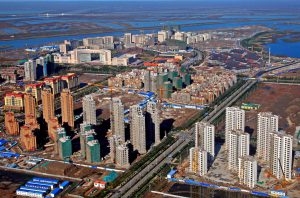Stockholm has been recognised for its innovative take on urban sustainability, combining grand visions and goals (such as becoming 100% fossil fuel-free by 2050) with practical interventions and measures (such as congestion charging and eco-profiled major redevelopment areas). It has therefore often been suggested that Stockholm can be a role model or ‘best practice’ for other cities around the world. But what is behind this apparent success story?
Part of the answer is a long history of political initiatives, stretching back to the welfare policies of the mid-1900s, which were implemented to improve wellbeing and health, but also contributed to urban settlement and resource use patterns that we generally consider “sustainable.”
For instance, at the time of its construction, the underground system built between the 1950s and 1980s was arguably grossly over-dimensioned, but many argue that it helped Stockholm avoid the sprawl that characterises many other major cities. Another major factor was national legislation introduced from the 1960s and onwards to protect the environment. The ‘third wave’ of policies strongly affecting the sustainable urban development of Stockholm emerged in the late 1990s and early 2000s, with plans for the design of new, sustainable urban districts. The most ambitious and extensive of these is “Hammarby Sjöstad”, which has become the most famous example of sustainable urban development in Stockholm, and inspired many other international projects, such as the Tangshan Bay development initiative in China.
Sustainable growth or mirage?
In these contexts it is often argued that Sweden has managed to increase GDP growth and at the same time decrease carbon dioxide emissions. Nevertheless, many researchers that have studied the calculations behind these claims argue that much of the apparent decline in emissions in reality simply are the results of emissions being displaced to other parts of the world – an “out of sight, out of mind” – attitude. Therefore, such strategies may indeed exacerbate global inequalities in development, where environmental ‘bads’, such as dangerous or environmentally harmful processes of goods production, are not really mitigated but rather conveniently exported to other places.
In this sense, it may appear as if the global narrative presently being woven around Stockholm, as a beacon of urban sustainability, is sometimes a bit uncritical and almost utopian. Nevertheless, just because the green profile of Stockholm includes some dubious marketing components, this does not necessarily mean that it lacks substance. There are many serious projects and ambitions in Stockholm in the area of sustainable urban development.
We also need to keep in mind that no city is a self-sufficient island, but rather represents nodes within networks that both constitute and are constituted by innumerable flows of people, ideas, and resources – flows at the intersections of which the phenomenon of urbanisation is generated.
Contrary to such a relational understanding of cities and neighbourhoods, best-practice examples of ‘sustainable urban districts’ and ‘eco cities’ are today sold as “ready to export” package solutions on the global market. We would like to argue that we should not stare ourselves blind at the sight of such, admittedly dazzling, projects when trying to learn from other places – but also try to understand what wider institutional and systemic capacities can generate a broad, substantial impact in urban development. Otherwise, we risk constructing fashionable and only purportedly ‘sustainable’ enclaves embedded in a wider, wholly unsustainable urban fabric.
Key questions for policymakers
A number of key questions crystallised in our research on sustainable urban development in Stockholm. These may be helpful for other cities and places in thinking about sustainable urban development. The first is to ask how, why and what we think of as sustainable policy or investment is a reflection of political, economic and social history; what we credit as “best urban sustainability practice” is often developed for reasons other than preserving the natural environment. This doesn’t imply that cities should stop developing policies specifically aiming at sustainability. Instead, it means that cities always should consider the potentially positive or adverse sustainability effects of every policy decision, without relegating sustainability issues to a separate domain – where they sometimes can become isolated from all the other activities going on in a city administration.
A second exercise is to identify the ways in which the character of a particular urban setting—natural, political and cultural—both opens new opportunities for improving sustainability or creates new roadblocks. For example: the consensus orientation of Swedish political culture has arguably contributed both to a critical “staying power” of sustainability policies and initiatives, but may raise sustainability issues to a level of abstraction that becomes muddled in specific development contexts, making agreement upon vague ideals easy but at the same time risking to hamper concrete advancements in practice.
Finally, cities must consider how societal goals for collective sustainable behaviour can be achieved in modern urban societies strongly influenced by global cultural trends favouring individual choice and consumption. It is, for instance, difficult to earnestly discuss the sustainability of a city without taking into regard the consumption patterns and practices of its inhabitants, and the environmental degradation generated through these lifestyles, in the place of consumption – but also at the sites of production of the goods.
The challenge of sustainable urban development
Up to the end of the twentieth century, broad actions aimed to protect the environment were generally considered to significantly improve quality of life through major innovations and investments in increased transit accessibility, cleaner water, and protected recreational and living environments which aimed at benefitting the whole population and not just small groups or economic elites.
In more recent decades, and paralleling the rapid global diffusion of the Western consumerist lifestyle ideal, environmental measures have often been cast as threats or restrictions to the comforts of the “good life.” The policies that have been most easily accepted are those that save consumers time, energy, or money as well as the environment. Recently, interest has turned to innovative and often “silent” or “passive” green technology, neatly avoiding uncomfortable discussions regarding established ideals of personal consumption, freedom and individual lifestyle choices.
Nevertheless, if urban decision-makers are serious in their ambition to achieve sustainable urban development, the day may come sooner rather than later when some difficult choices have to be made. These concern not only how to ramp up innovations in technology and facilitate green consumption and green growth, but also how to balance individual and collective needs in the longer as well as the shorter term – taking into account the local, trans-local, and global impacts of local activities.
For, even if Stockholm is deservedly recognised as the leading European city with regard to sustainable urban development – in this field “best” might actually be far from good enough. If the aim is to achieve truly sustainable development on a global basis, we can never afford to lose sight of the broader picture.
The anthology upon which this article is based was made possible by a grant from Formas and The Swedish Research Council for Environment, Agricultural Sciences and Spatial Planning





